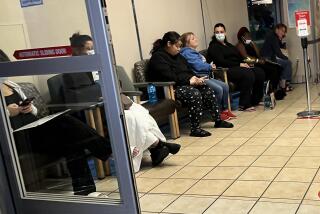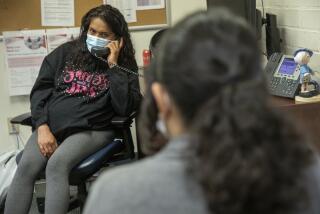Patients Giving Up On Emergency Rooms : Health: Studies find pain, not impatience, drives many away from overcrowded public hospitals. Waits of several hours are common.
- Share via
Long waits in hospital emergency rooms are driving away some patients in urgent need of medical treatment, researchers at two California public hospitals have found.
Their findings challenge the long-held belief that patients who walk out of emergency rooms generally have minor problems and do not suffer greatly by leaving.
Researchers at Los Angeles County Harbor-UCLA Medical Center in Torrance and at San Francisco General Hospital found that many patients left not out of impatience but because they were in too much pain or discomfort to tolerate waiting any longer.
Waiting times at the San Francisco hospital averaged 3.5 hours, but stretched as long as 17 hours for some patients. The UCLA researchers found that patients who left the Harbor-UCLA emergency room before a doctor could see them had waited an average of 6.4 hours. The majority improved on their own. But some had significant medical problems that worsened. One in 10 in the UCLA group required hospitalization within a week of their aborted visit to the emergency room.
“There has been this myth that if someone is really sick in this country they will be able to get timely medical care,” said Dr. David W. Baker, visiting assistant professor of medicine at UCLA and lead author of the Harbor-UCLA study. “Our study says that this is just not true.”
The California studies were reported today in the Journal of the American Medical Assn. An accompanying editorial calls them part of mounting evidence that health care in the United States has reached a “critical state,” unable to meet “the basic needs of a substantial segment of our population.”
The UCLA and UC San Francisco reports also contribute grim detail to a chronicle of critical overload in the nation’s emergency rooms published in the September, 1991, issue of the Annals of Emergency Medicine.
A major reason for the overload, experts say, is the increasing number of poor and uninsured Americans who rely on emergency rooms for routine medical care.
“If you can’t find a doctor because you have no health insurance or are on Medi-Cal, then the county hospital often becomes your family physician,” said Mary Pitman, president of the California Assn. of Public Hospitals.
Researchers in the Annals study surveyed the emergency rooms of 239 teaching hospitals in 40 states. They found severe overcrowding in many, leading to delays and erosion of the quality of care. Emergency department staffs, overwhelmed by their load, told researchers they frequently resorted to strategies to keep patients out, including diverting ambulances to other hospitals, periodically closing their emergency rooms and refusing transfers of patients from other hospitals.
The Annals study focused on how long patients already sick enough to be admitted to the hospital must wait to get from the emergency room to a hospital bed. It contrasts with the UCLA and UC San Francisco studies, which looked at people who never made it as far as a doctor’s examining room.
All of the patients are part of the same crowded picture. To the extent that very sick patients back up in the emergency room waiting for beds, staff seeing to their care are unable to get to people in the waiting room.
“We are being asked to fulfill a role that emergency departments were never designed to do: ongoing care for acutely ill patients for hours and sometimes days while they wait for beds in the hospital,” said Dr. Arthur L. Kellermann, an author of the Annals study as well as of an editorial on the California studies in the Journal of the American Medical Assn. Kellermann is chief of emergency medicine at the University of Tennessee.
Emergency rooms are organized to deal with the sickest patients first. As people arrive, they are evaluated to determine who needs immediate care and who can wait. The more patients, the larger and sicker the group left to wait. Those arriving by ambulance from accidents or with other serious problems generally go to the head of the line.
The UC San Francisco team followed 700 walk-in patients at San Francisco General during a week in July, 1990. Of this number, 15%, or 102 patients identified by the nurses as needing medical attention, left without it. Most got better on their own, just as a majority of those who stayed reported improvements in their health. But twice as many people in the untreated group said their pain or illness had worsened. Four required hospitalization.
The UCLA team followed up on 186 patients who left untreated out of 2,259 who came to the Harbor-UCLA emergency room during a two-week period in spring, 1990. They had waited an average of 6.4 hours. Many of the patients who stayed to be treated waited longer than 10 hours, according to Baker.
Of those who walked out, 46% were judged by the nurses to be in need of “prompt medical evaluation,” according to the study. Some of those hospitalized in the following week had life-threatening conditions, including bleeding ulcers, serious infections and dangerously high blood pressure.
One young man, complaining of severe abdominal pain, stood in the waiting room for three hours because sitting made his pain worse, UCLA’s Baker recalled. He left because he felt he had to lie down. When he returned the next day, doctors rushed him into surgery for appendicitis.
Another patient who left, but soon after required hospitalization, had swallowed glass in an apparent suicide attempt.
The UCLA and UC San Francisco studies focused on hospitals that are institutions of last resort for patients who cannot afford private medical care. San Francisco General is the only full-service public hospital in the city; Harbor-UCLA is one of six public hospitals in Los Angeles County.
In the national survey on emergency room overcrowding, Kellermann and his colleagues generally found public hospitals to be harder hit than private facilities. While the average waiting time nationally for patients to be transferred from the emergency room to a general care bed was 3.5 hours, patients in especially crowded hospitals waited three days.
Among major cities, New York hospitals reported the longest average wait--10.3 hours. Detroit was second at 4.4 hours and Los Angeles was third at 3.5 hours. All of these figures, however, are based on 1988 data; Kellermann said current data would probably show conditions to have worsened.
Calvin P. Kwan, assistant administrator at Harbor, said the hospital is trying to alleviate overcrowding in the emergency room by speeding up the availability of beds.
He also said a new 45,000-square-foot primary care center, to be constructed in 1992, is expected to relieve up to 20% of the emergency room load.
Long Waits in the Emergency Room
A study at Los Angeles County Harbor-UCLA Medical Center in Torrance showed that some seriously ill patients, discouraged by waits that averaged 6.4 hours, are leaving the emergency room before treatment. An increasing number of poor and uninsured patients has lengthened the overall waiting time. 1986-87 Patients seen annually in emergency room: 108,900 Patients who left before seeing a doctor: 2,570 1987-88 Patients seen annually in emergency room: 102,700 Patients who left before seeing a doctor: 5,201 1988-89 Patients seen annually in emergency room: 109,600 Patients who left before seeing a doctor: 5,955 1989-90 Patients seen annually in emergency room: 110,900 Patients who left before seeing a doctor: 7,158 1990-91 Patients seen annually in emergency room: 108,100 Patients who left before seeing a doctor: 8,287 Source: Department of Emergency Medicine, Harbor-UCLA
More to Read
Sign up for Essential California
The most important California stories and recommendations in your inbox every morning.
You may occasionally receive promotional content from the Los Angeles Times.









